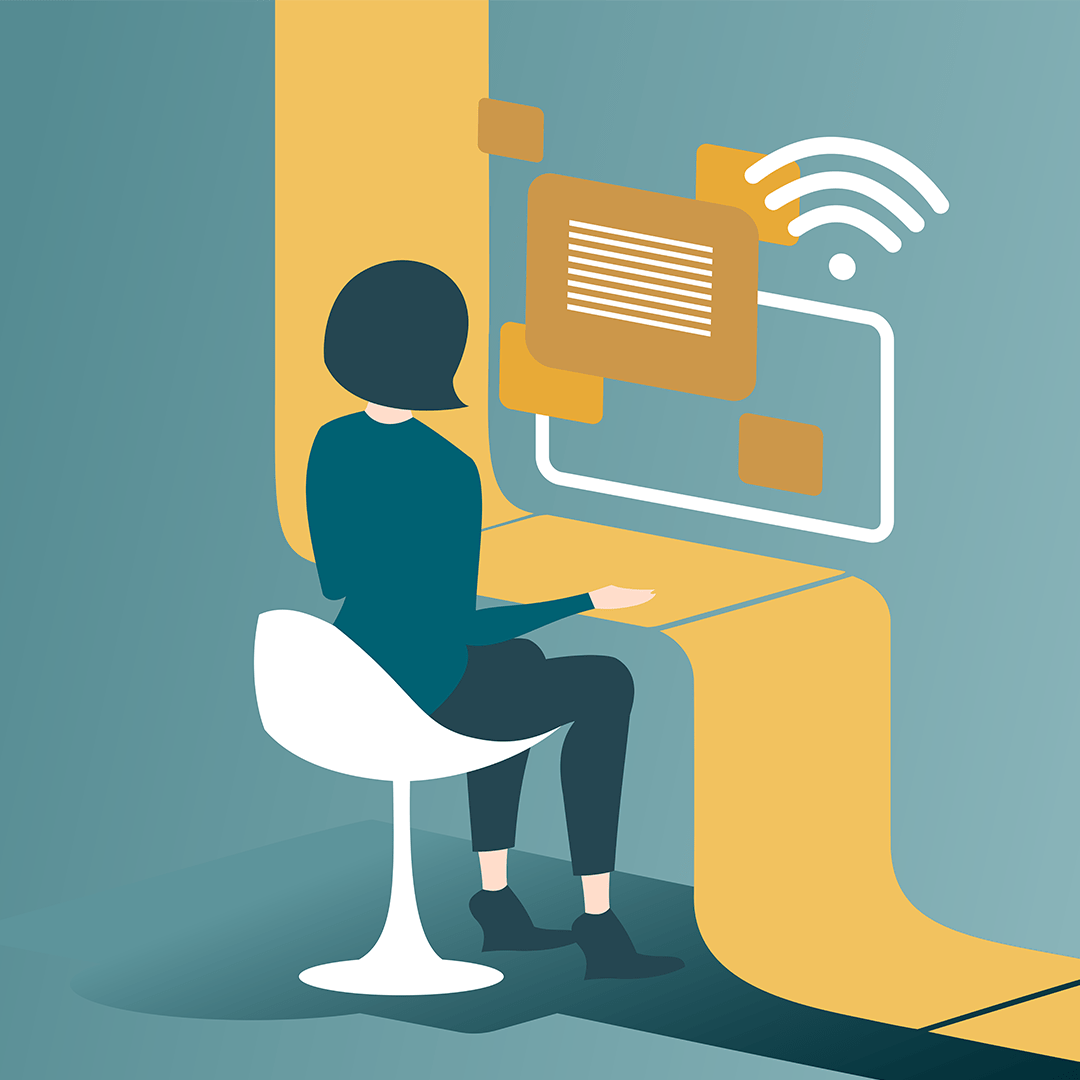
By Kevin Cox, AWS SAA, CCSK
Lead Consultant, Impact Makers
Why use Desktop as a Service?
Desktop as a Service, or ‘DaaS’, represents computers that you access over a network and remotely control just like a normal computer. That network could be the internet or a company network. You can be hundreds of miles away from a desktop. This easy access allows an organization to provide a standardized computing platform that meets the business needs, eliminate the challenges of buying individual laptops or desktops, no need for mailing or shipping the computers to home-based employees, providing a standard format computer, and enabling an extremely flexible capability for remote workers and/or telecommuting. The ability to streamline support to remote workers and/or telecommuters is the primary driver for using DaaS.
There are many ways to make DaaS available. The legacy method is hosting and providing the remote desktops out of an on-premise data center. This is a tremendous capital investment in storage, servers, licensing, and network configuration. This method is often referred to as virtual desktop infrastructure (VDI). The cloud has superseded this method and offers scalability, pay as you go, and removes the hurdle of large capital expenses. Since cloud is a service that is on demand, the newer term to describe remote desktops is Desktop as a Service.
DaaS can be quickly set up, configured, and delivered. Depending the configurations needed, this could be less than a week for a small deployment. Obviously, the more complex the environment, the more time it can take to configure and deliver. Taking advantage of a cloud offering for DaaS can enable a business to quickly gain the capability to provide remote worker options in a very short time.
Similar Technology to Desktop as a Service
It can be very confusing to compare other remote control software to DaaS. Here are some similar tools and where they differ from DaaS. Software like Microsoft Windows Remote Desktop Services, Citrix XenDesktop, and VMware Horizon all provide a similar remote desktop like the cloud-based DaaS, but they typically operate in your own datacenter at a capital investment cost model. You will need to pay for what you think you might need ahead of time. When you finish using the software, the cost is not pay-as-you-go, you pay for the capital investment regardless of the usage pattern. You are not able to recoup costs on the storage, servers, and networking gear needed for on-prem technology if you stop using it or when it becomes obsolete. Consider the cost to upgrade every 3-4 years to keep a competitive performance business desktop. In the cloud, this upgrade is handled by a provider like AWS in the pay-as-you-go costs. Many vendors offer the products as a cloud service, but this is bolting an on-premise platform to cloud without providing integration with other native cloud services like AWS provides with their DaaS.
Other remote software platforms to compare are products like Google Chrome Remote Desktop, VNC, Logmein, individual Remote Desktop protocol (RDP) clients, and Apple Remote Desktop. This type of software is a control tool that allows you to take remote control of a computer that has the remote desktop client installed. The remote computer is not hosted in a cloud like DaaS, it is not standardized hardware, lacks included management controls, no upgrades are provided for the remote desktop, and there are technical limitations on the client as well as the controlling PC. This type of remote desktop is not an apples-to-apples comparison to a DaaS offering; these products are only the remote control portion, not the actual desktop. For a company that needs to provide remote desktop options for more than 5-10 users, it is very difficult to scale this technology. You will still need to procure physical laptops or desktops. Also consider how you would engage support if there was an issue – the support options vary.
Options in the Cloud for Desktop as a Service
Desktop as a Service is just like the Software as a Service model, meaning it’s a cloud service and dedicated to providing desktops. This provides many benefits that include the following:
- Pay for only what you use, when you use it, no long-term buying
- No upfront capital investment of servers, storage, networking, and licensing
- Easily scaled up if you need more or scaled down for less
- Automatic shutdown of desktops to save money when they are not in use
- Easy provisioning of desktops
- Very reliable desktops
- Often includes common software and add-ons like online meeting and video conferencing
- No obsolete computers left when you upgrade or change performance modelsAll the administration of the complex storage, compute, and networking is done by the cloud service provider
There are various configurations for Desktop as a Service that should be considered. Many Desktop as a Service offerings do not “remember” the user’s settings like bookmarks, shortcuts, or preferences. Other DaaS configurations do not keep any saved or downloaded documents after a connection is completed; this is referred to as non-persistent storage. Typically, this configuration does not match a single desktop to a dedicated user. Another way to provide DaaS is a matching of the remote user to a dedicated desktop. The user’s settings and preferences are saved, and storage is preserved between connections and reboots. The second configuration behaves more like a normal end user computing experience.
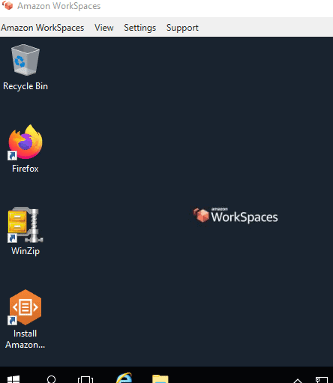 Default AWS Workspaces desktop view from a Windows client
Default AWS Workspaces desktop view from a Windows client
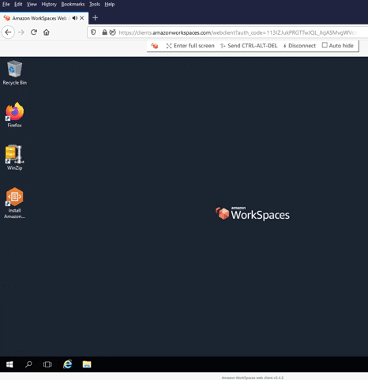 Default AWS Workspaces desktop view from Firefox browser
Default AWS Workspaces desktop view from Firefox browser
A DaaS can be configured to be part of the corporate network and inherit any special configurations like software packages, appearance, shortcuts, mapped drives. Many DaaS providers, like AWS, also provide software to allow the remote user to connect using a web browser like Firefox, tablets, Chromebooks, Mac/IOS, Windows, and even Linux. This gives the remote user tremendous flexibility and saves the organization from investing in the client devices. You can also think of the client devices as the device where the user is physically sitting.
From an operational perspective, these features are supported in AWS Workspaces DaaS:
- Tools for managing remote employees
- Access to the cloud desktop from remote worker / telecommuter computers, web browsers, tablets, bring your own device
- Easy to change the performance level of the remote computer
- Customized appearance and controls
- Automated backups
- Troubleshooting a problem is often not needed, just create a new remote desktop
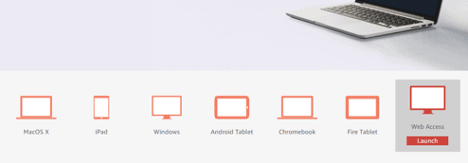 AWS Workspaces client offerings
AWS Workspaces client offerings
Security for Desktop as a Service
A Desktop as a Service provides all the needed security and controls for the remote desktop environment. A company can protect their data and even improve security over using physical laptops. Features like these can be supported in a typical Desktop as a Service:
• Internet browsing controls
• Encrypting data in flight and at rest
• USB drives disabled
• Many authentication methods supported
• Copy and Paste disabled between remote client and remote desktop
• Removing local administrator rights
• Client based printing can be disabled
AWS Workspaces for Desktop as a Service
At Impact Makers, we have successfully delivered environments using AWS Workspaces for hundreds of remote users. For a low, pay-as-you-go fee, Amazon WorkSpaces provides a complete cloud-based virtual desktop service, including compute, persistent solid-state storage (SSD), and applications. Your users get a better experience and more functionality than a traditional PC, and you get a simpler way to provision desktops for users, at much lower costs than an on-premises VDI solution. This AWS service has tremendous flexibility, and we work with clients to tailor a solution that meets many requirements. Workspaces can provide a basic environment to quickly scale and deliver remote desktops. Workspaces can also be used for providing remote desktops in a complex and compliance-driven business environment. We understand all the ecosystem beyond the desktop and have the capability to provide internet filtering, storage options, encryption, and other configurations. We can help you understand the operational costs versus the VDI capital costs and the net impact to your business.
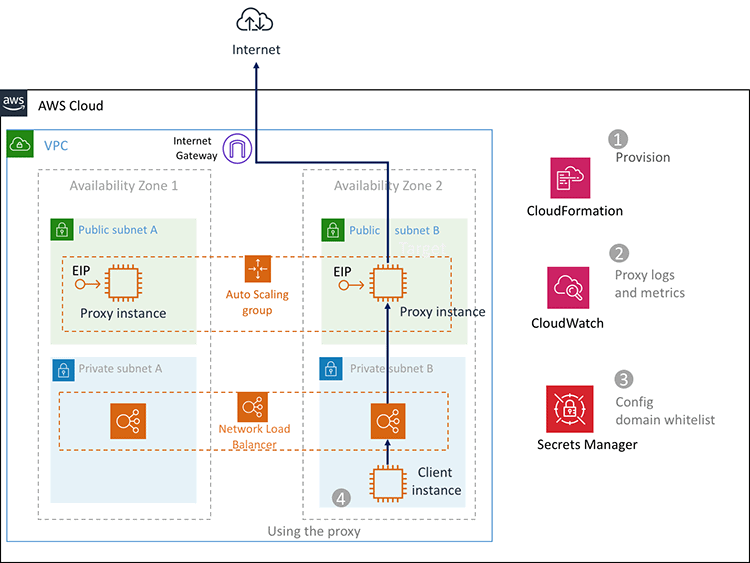 AWS Workspaces web filtering diagram
AWS Workspaces web filtering diagram
The Impact Makers Solution
Impact Makers is an AWS Advanced Consulting Partner. We leverage comprehensive and mature practices to enable customers to see all facets of their AWS ecosystem. Every project has unique elements that must be incorporated into a comprehensive strategy in addition to identification and execution of technical work. As Advanced AWS Consulting Partners, we recognize the importance of a secure, reliable, and flexible Desktop as a Service. Our comprehensive framework includes the AWS Well Architected Framework and industry best practices in addition to elements like compliance , asset and metadata management, business strategy alignment, service portfolio management, support model definition, service design and deploy, CloudOps and much more. We work with our customers to deliver and enable strategic business advantage with cloud services.
To learn more, contact us.
